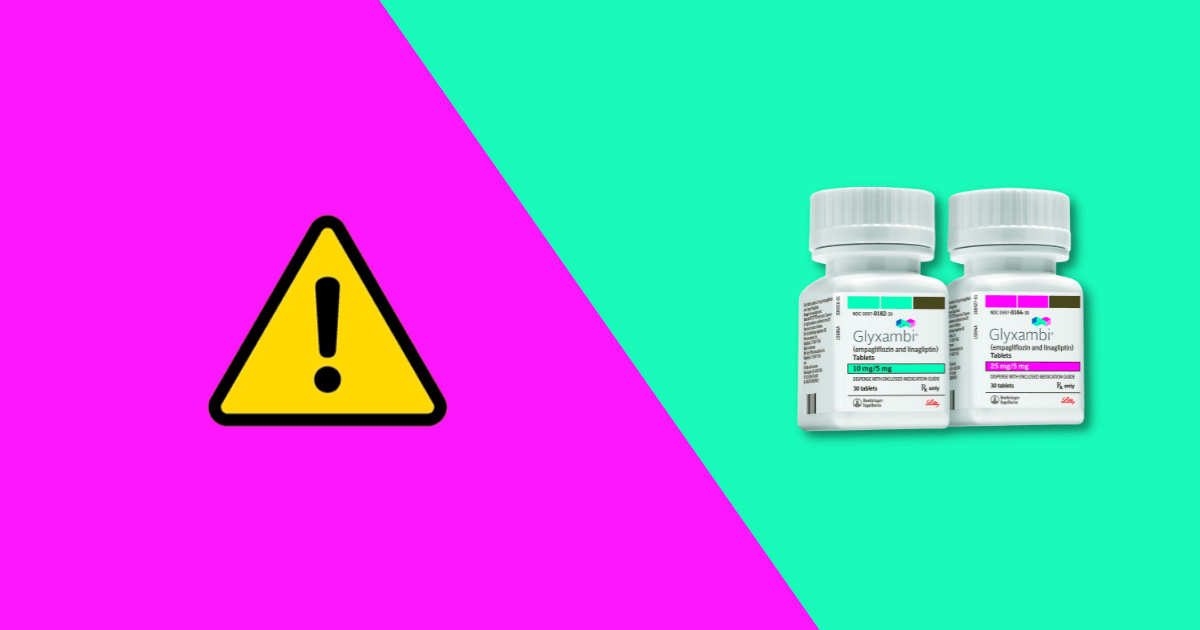Glyxambi side effects and how to avoid them
Table of contents
Glyxambi is a brand-name medication manufactured by Boehringer Ingelheim Pharmaceuticals, Inc., used to help manage blood sugar levels in patients with type 2 diabetes. While Glyxambi is generally well tolerated, there are some potential side effects that people should be aware of. The most common side effects of Glyxambi include upper respiratory tract infections. Less common but more serious side effects can include serious allergic reactions. Learn more about the side effects of Glyxambi and what you can do to avoid them.
What is Glyxambi?
Glyxambi is a diabetes medication used to reduce high blood sugar levels if you have type 2 diabetes. Type 2 diabetes mellitus is a condition where you have high blood sugar levels most of the time. Glyxambi encourages your pancreas to produce insulin for longer, helping you absorb more glucose from your blood. It also causes you to lose more sugar when you urinate. These two effects can help you maintain lower blood sugar levels.
Glyxambi contains empagliflozin, a sodium-glucose co-transporter inhibitor (SGLT2 inhibitor), and linagliptin, a dipeptidyl peptidase-4 inhibitor (DPP-4 inhibitor).
Empagliflozin increases the amount of sugar in your urine. An enzyme called SGLT2 reabsorbs sugar from your urine to allow your body to use as much of the sugar you eat as possible. But empagliflozin blocks the SGLT2 enzyme. This limits the amount of sugar you absorb from your urine and means you lose more when you urinate. Empagliflozin is also used to reduce the risk of death from heart attacks and stroke in people with type 2 diabetes and cardiovascular disease.
Linagliptin increases the amount of insulin you produce after you’ve eaten. When you digest food, you release digestive hormones that make your pancreas secrete insulin. As you continue to digest your food, these digestive hormones are broken down by an enzyme called DPP-4 to allow your levels of insulin to fall again. Linagliptin stops this from happening. It blocks the DPP-4 enzyme breaking down these digestive hormones, keeping them active for longer, making you produce more insulin.
Glyxambi dosage
Glyxambi is available in tablet form in the following doses: 10 mg empagliflozin/5 mg linagliptin and 25 mg empagliflozin/5 mg linagliptin.
Glyxambi is usually taken once a day, with or without food. If you forget to take Glyxambi, take it as soon as you remember. If it is almost time for your next dose, skip the missed dose and take your next dose at the scheduled time.
You are advised to read the prescribing information provided with this medicine for the drug information and patient information, and always speak with your healthcare provider for medical advice about any changes to your dose so they can monitor and evaluate your condition.
Glyxambi side effects
The most common side effects caused by Glyxambi include the following:
- Cough, sore throat
- Inflamed nose or throat
- Upper respiratory tract infections
- Itching, skin rash
- Increased thirst and urination
- Genital yeast infections
- An increase in the blood enzyme amylase
- An increase in the pancreas enzyme lipase
In rare instances, Glyxambi can cause more serious side effects, including:
- Life-threatening allergic reactions – hives, itching, peeling skin, trouble swallowing, difficulty breathing, swelling of the face, lips, tongue or throat
- Heart failure
- Gallstones
- Inflammation of the pancreas (pancreatitis)
- Kidney problems
- Serious urinary tract infections
- Hypoglycemia – having too low blood sugar (symptoms of low blood sugar include lightheadedness, shakiness, and fainting)
- Increased cholesterol
- Diabetic ketoacidosis – a buildup of ketones in your blood (symptoms include nausea, vomiting, abdominal pain, confusion, lightheadedness, unusual tiredness, shortness of breath, and trouble breathing
- Serious skin reactions that can cause blistering and shedding of skin
- Bullous pemphigoid, skin reactions such as rash, urticaria
- Necrotizing fasciitis – a rare but serious bacterial infection of the tissue under the skin
- Fournier’s gangrene (an infection of the genital area)
- Urosepsis
- Severe joint pain (arthralgia)
If you experience any of these serious side effects, stop taking Glyxambi and seek medical attention immediately. You are encouraged to report the negative side effects of prescription drugs to the FDA. Visit www.fda.gov/medwatch, or call 1-800-FDA-1088.
Does Glyxambi cause weight loss?
No. Weight loss or weight gain are not side effects of Glyxambi. Speak to your doctor if you experience this side effect when taking Glyxambi.
Does Glyxambi cause kidney damage?
Glyxambi may cause infections that spread to the kidneys causing kidney damage and kidney failure.
Glyxambi drug interactions
Glyxambi can interact with other medications. When this happens, it can change how Glyxambi and the other medications work and make some side effects more likely. Tell your prescribing physician about all drugs you’re taking, particularly:
- Insulin secretagogues or any other medications, such as sulfonylureas that can lower your blood sugar
- Any diuretics (water pills)
- Rifampin, an antibiotic used to treat tuberculosis
Before taking Glyxambi, be sure to tell your doctor about all of the medications you are taking, including over-the-counter drugs and supplements, to ensure they are safe to take at the same time.
Glyxambi contraindications
Glyxambi isn’t suitable for everyone. Don’t take Glyxambi if you:
- Are allergic to the active ingredients empagliflozin or linagliptin
- Are allergic to any of the other ingredients in Glyxambi
- Have type 1 diabetes
- Have severe kidney problems or are on dialysis
- Are under 18 years of age
Talk to your physician before taking Glyxambi if you:
- Are taking any of the medications that could interact with Glyxambi
- Have kidney disease or any other kidney problems
- Have liver problems
- Have hypotension (low blood pressure)
- Have a history of pancreatitis
- Have a history of genital yeast infections
- Have a history of urinary tract infections or problems with urination
- Are due to have surgery
- Are eating less due to illness, surgery, or a change in your diet
- Often drink alcohol or binge drink alcohol
- Are pregnant or are planning to get pregnant
- Are breastfeeding or are planning to breastfeed
- Are over 75 years of age
You should always check with your doctor or pharmacist before taking any medication, including Glyxambi, to ensure it is safe for you.
Glyxambi vs Jardiance
Glyxambi contains a combination of empagliflozin and linagliptin. Jardiance contains empagliflozin only. While Glyxambi may be used to treat the same conditions as Jardiance, it may also be used to treat additional medical conditions. Glyxambi will, however, also cause certain side effects that Jardinace does not.
What are the benefits of Glyxambi?
Glyxambi is used in combination with diet and exercise to control high blood sugar in people with type 2 diabetes, helping to prevent kidney damage, loss of limbs, and sexual function problems.
Can you take Glyxambi and metformin together?
Empagliflozin and metformin are used in combination with a healthy diet and exercise to treat high blood sugar caused by type 2 diabetes.
How to avoid Glyxambi side effects
The best way to avoid side effects is to take Glyxambi as directed by your doctor. Follow your doctor’s instructions carefully, and do not take more or less than prescribed.
If you experience any side effects, talk to your doctor or pharmacist. They may be able to recommend ways to help reduce or prevent some of the side effects.
1. Stick to the recommended dosage
Take your prescribed dose of Glyxambi that has been recommended by your healthcare professional. Do not take more or less than prescribed.
2. Monitor your blood sugar levels
If you have diabetes, it is important to monitor your blood sugar levels closely while taking Glyxambi. Check your blood sugar levels as directed by your doctor and report any changes to your doctor immediately.
3. Drink plenty of fluids
Drink eight to 10 glasses of water or fluids every day to help prevent dehydration, which can make side effects worse.
4. Avoid alcohol
You may drink alcohol while taking Glyxambi, however, drinking more than 2 units of alcohol each day can increase your risk of low blood sugar levels.
5. Don’t skip meals
Eating regular meals and snacks will help to prevent low blood sugar levels (hypoglycemia).
6. Check your feet
If you have diabetes, check your feet for any cuts, sores, or redness regularly. Tell your doctor if you experience any problems with your feet while taking Glyxambi.
7. Know the signs and symptoms of Glyxambi side effects
Signs and symptoms of side effects include upper respiratory tract infections. If you experience these symptoms, speak to your doctor for medical advice.
8. Tell your doctor about all medications you’re taking
Be sure to tell your doctor about all other medications you’re taking, including over-the-counter drugs, vitamins, and herbal supplements, as they can interact with Glyxambi.
9. Get regular medical checkups
It is important to get regular medical checkups and monitor your medical conditions. Your doctor will monitor your side effects and may adjust your dose of Glyxambi as needed.
Medically reviewed
A medical professional has reviewed this article.


Jamie Winn, PharmD
Jamie Winn, PharmD
Dr. Jamie Winn received his Doctor of Pharmacy in 2002 from the University of South Carolina College of Pharmacy, Columbia, SC. Jamie is a medical reviewer for NiceRx.

